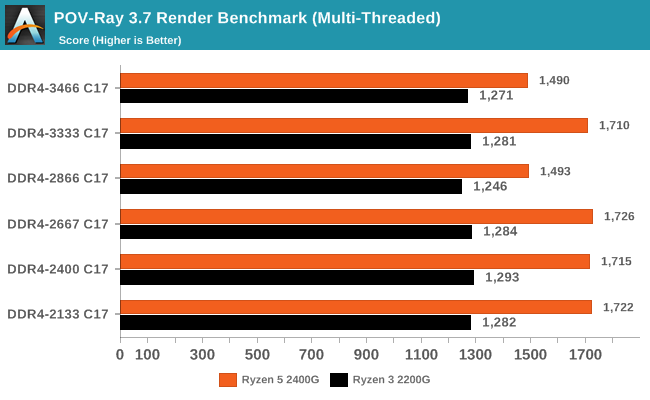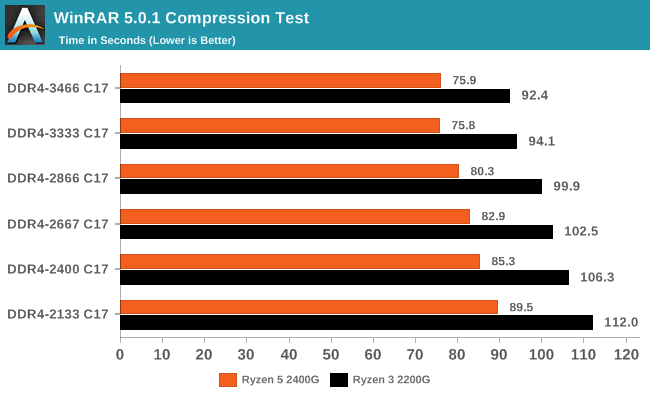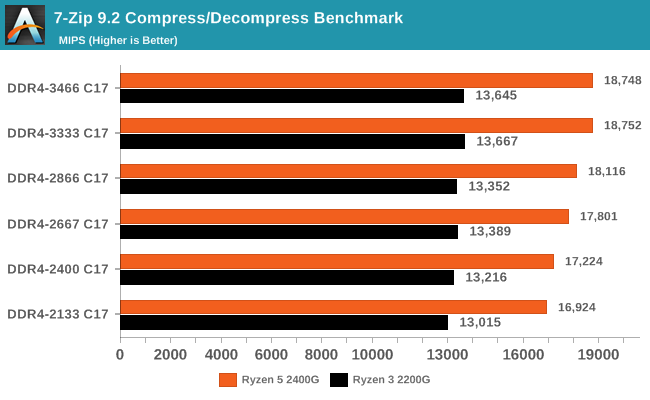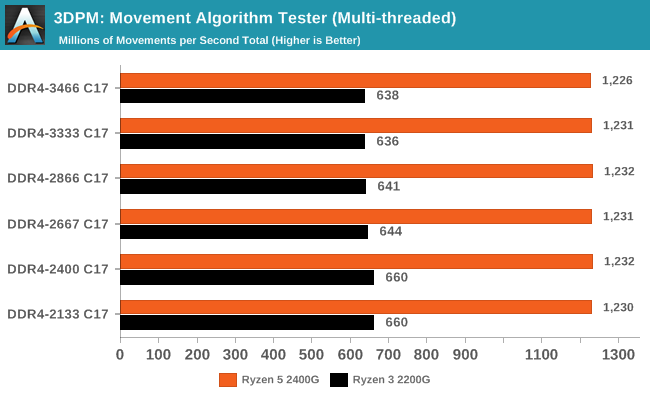Zen and Vega DDR4 Memory Scaling on AMD's APUs
by Gavin Bonshor on June 28, 2018 9:00 AM EST- Posted in
- CPUs
- Memory
- G.Skill
- AMD
- DDR4
- DRAM
- APU
- Ryzen
- Raven Ridge
- Scaling
- Ryzen 3 2200G
- Ryzen 5 2400G
CPU Performance
Rendering - Blender 2.78: link
For a render that has been around for what seems like ages, Blender is still a highly popular tool. We managed to wrap up a standard workload into the February 5 nightly build of Blender and measure the time it takes to render the first frame of the scene. Being one of the bigger open source tools out there, it means both AMD and Intel work actively to help improve the codebase, for better or for worse on their own/each other's microarchitecture.

While memory speed does influence our final rendering duration consistently by shaving seconds off, the jump from DDR4-2133 to DDR4-3333 equates to a 2% reduction overall on the Ryzen 3 2200G, although the last step from 3333 to 3466 is actually a regression. The Ryzen 5 2400G experienced a reduction of just under 4%.
Rendering – POV-Ray 3.7: link
The Persistence of Vision Ray Tracer, or POV-Ray, is a freeware package for as the name suggests, ray tracing. It is a pure renderer, rather than modeling software, but the latest beta version contains a handy benchmark for stressing all processing threads on a platform. We have been using this test in motherboard reviews to test memory stability at various CPU speeds to good effect – if it passes the test, the IMC in the CPU is stable for a given CPU speed. As a CPU test, it runs for approximately 1-2 minutes on high-end platforms.

Our results in POV-Ray 3.7 were a little hit and miss and showed irregularities at different memory clock speeds, perhaps due to the additional power required by the memory controller at higher frequencies taking away from available CPU power. This means POV-Ray isn’t really influenced more by the memory speeds themselves, although it is certainly more determined from more CPU cores and higher frequencies as the difference between the 2200G and 2400G show.
WinRAR 5.4: link
Our WinRAR test from 2013 is updated to the latest version of WinRAR at the start of 2014. We compress a set of 2867 files across 320 folders totaling 1.52 GB in size – 95% of these files are small typical website files, and the rest (90% of the size) are small 30-second 720p videos.

As the memory frequency was increased, the compression time was consistently lower going up a memory strap. With WinRAR being one of our most DRAM-affected CPU tests, we have seen this before with other CPU generations. The 2200G saw a 21% increase in throughput, while the 2400G had a +18% gain. However it is worth noting that the DDR4-3466 time was slightly slower than that of the DDR4-3333 time again.
7-Zip 9.2: link
As an open source compression tool, 7-Zip is a popular tool for making sets of files easier to handle and transfer. The software offers up its own benchmark, to which we report the result.

The 7-Zip results are interesting as with both Ryzen based APUs at the DDR4-3333 setting saw the biggest benefit in compression and decompressing. Again, the top strap in our testing was not the most performant. Overall gains were +11% for the 2400G, and +5% for the 2200G, in line with thread counts.
Point Calculations – 3D Movement Algorithm Test: link
3DPM is a self-penned benchmark, taking basic 3D movement algorithms used in Brownian Motion simulations and testing them for speed. High floating point performance, MHz, and IPC win in the single thread version, whereas the multithread version has to handle the threads and loves more cores. For a brief explanation of the platform agnostic coding behind this benchmark, see my forum post here.

With our 3DPM Brownian Motion simulator benchmark, memory frequency made little difference in increasing performance, although as our results show, the slower the memory, the better performance we experienced on the Ryzen 3 2200G. The Ryzen 2400G experienced a similar range of inconsistent and inconsequential results showing little to no improvement as the memory strap was increased.
Neuron Simulation - DigiCortex v1.20: link
The newest benchmark in our suite is DigiCortex, a simulation of biologically plausible neural network circuits, and simulates activity of neurons and synapses. DigiCortex relies heavily on a mix of DRAM speed and computational throughput, indicating that systems which apply memory profiles properly should benefit and those that play fast and loose with overclocking settings might get some extra speed up. Results are taken during the steady state period in a 32k neuron simulation and represented as a function of the ability to simulate in real time (1.000x equals real-time).

DigiCortex experienced a very subsequent increase throughout the tested memory straps on both the Ryzen APUs, with a nice jump in performance of 22% on the 2200G and on the 2400G.










74 Comments
View All Comments
GreenReaper - Saturday, June 30, 2018 - link
Not sure CISC vs. RISC is right here - SIMD, sure, since that operates on large blocks of memory and so should be more suitable for GDDR's larger bus size.,peevee - Tuesday, July 3, 2018 - link
Type of memory does not determine bus size.128-bit GDDR5 is exactly as wide as 2-channel DDR4 in all the cheap CPUs.
But it is a little bit smarter - for example, it contains hardware clear operation - no need to write a whole lot of zeros...
close - Saturday, June 30, 2018 - link
DDR3 has been in use since 2007. Adoption rate aside, the cycle reached a peak with DDR3's 7 year reign and it might come back down if DDR5 comes soon.DDR1 was announced in 2000, DDR2 in 2003, DDR3 in 2007, DDR4 in 2014. DDR5 is rumored for next year.
peevee - Tuesday, July 3, 2018 - link
" DDR is optimized for cisc operations while GDDR is optimized for risc operations"What a load of BS... Learn, people, before writing.
niva - Tuesday, July 3, 2018 - link
I always thought it was that GDDR was faster memory that can't be mass produced in quantities to satisfy DRAM market, not that there was something fundementally different about the memory. I also questioned that RISC vs. CISC statement but simple google searching reveals this: https://www.quora.com/What-is-the-difference-betwe...So perhaps that wasn't way off base.
Dragonstongue - Tuesday, July 3, 2018 - link
G for GDDR means GRAPHICS, DDR and GDDR "same thing"in theory "however"GDDR is not the same as DDR. Overall, GDDR is built for much higher bandwidth, thanks to a wider memory bus.
GDDR has lower power and heat dispersal requirements compared to DDR, allowing for higher performance modules, with simpler cooling systems.
DDR1, DDR2, and DDR3 have a 64 bit bus (or 128 bit in dual channel). GDDR3, comparatively, commonly uses between a 256 bit bus and 512 bit bus, or interface (across 4-8 channels).
GDDR3 has a 4 bit prefetch and GDDR5 has an 8 bit prefetch, making GDDR5 twice as fast as GDDR3 in apples to apples comparisons.
GDDR can request and receive data on the same clock cycle, where DDR cannot.
DDR1 chips sends 8 data bits for every cycle of the clock, GDDR1 sends 16 data bits.
things get extra "confusing" when GDDR5 came out because whatever the "rating is" for example GDDR5 900 "clock" you take this number and quadruple it which is the "effective speed" so this 900 becomes 3600 as it has a wider bus available to it A and B GDDR can send and receive data at the same time on the same clock cycle (normal DDR cannot, from what I have read)
also GDDR is a chunk more expensive then "normal" DDR ram, though it does have multiple benefits.
I suppose one can look at "DDR SDRAM is optimised to handle data packets from various in small bits with very low latency e.g browsers, programs, anti-virus scans, messengers.
GDDR, on the other hand, can send and receive massive chunks of data on the same clock cycle.
(source) http://www.dignited.com/27670/gddr-vs-ddr-sdram-gd...
bananaforscale - Saturday, June 30, 2018 - link
You are complaining about DDR4 because APUs struggle with it? You're barking up the wrong tree. The issue is in using shared memory.peevee - Tuesday, July 3, 2018 - link
Or they could have supported 4 channels, given that they support 4 DIMMS anyway. Would be useful for CPU operations too, given that they run 8 threads in parallel...Dragonstongue - Tuesday, July 3, 2018 - link
AMD memory controller for desktop purposes is NOT built nor designed for quad channel usage, the cost is "not worth it" there is no way you can keep costs down for a "simple" APU for those looking for a computer on a budget and have access to quad channel memory A and B very very few things the average everyday consumer does with their computer needs or can effectively use beyond what AMD CPU have provided with their HT (hypertransport) or IF (infinity fabric for Ryzen) are able to provide with dual channel.More is not always better, most of the time it becomes chasing unicorns vs actually "needing it", you know, for those who have a massive wallet and buy it just to say they have it AH HAHA
Dragonstongue - Tuesday, July 3, 2018 - link
we have not had DDR4 "that long" compared to say DDR3 or DDR2 which were and have been out far far longerDDR (2000) DDR2 (2003) DDR3 (2007) DDR4 (2014)....if you are "bad at maths" ^..^
18+ years........15+ years.....11+ years.....4+ years
.
DDR5 should be towards end of 2018 though JEDEC is saying 2020 for end consumer (me and you) purchase.
It is not the raw "speed" holding things back FYI, latencies, cycle speed, bandwidth available, power required to keep them running, all the subtimings ALL matter in their own fashion (depending on the task they are being used for) I remember many DDR2 sticks that you could heavily overclock and they ran crazy fast but also got crazy hot and died early deaths (suicide runs)
I do not ever hear of this happening with DDR3 or DDR4 (lower volts and the chip makers such as Intel do their damndest to monitor/control the memory controller speeds and volts to avoid killing things, back in the day these same safeguards were not in place)
(max JEDEC certified specs best I can tell)
DDR 400, DDR2 1066, DDR3 2133. DDR4 3200
best "jump" on a percentage basis seems to have been from DDR to DDR2 (166.5%) DDR2 to DDR3 (100.1%) DDR3 to 4 (50%)
current spec (not finalized as of yet) for DDR5 are "up to" approximately double what the fastest current modules of DDR4 are rated for 4266-6400 (vs 3200) (33.3% "gain" or at the "best" (100%)
I hardly call either of those "double" but I am a simple man ^.^
SOOOOOO the major jump absolutely was ddr to ddr2 when comparing official "spec" of the fastest rated memory, obviously there is even faster that one can manage when you overclock or whatever, but this is not a guarantee either, ratings and specs are ratings and specs.
Now as far as "when are we going to get faster memory" that depends, can your cpu or motherboard "handle it" IMHO, nope, not at this point anyways, very few can "handle" say DDR4 4700 (G.Skill) and generally speaking the extreme "fastest" also suffer from far looser timings and subtimings and a marked increase in power required to "make it happen"
RAM is not a "simple" thing to crank up the speeds with everything getting a "nitrous boosT" like you could with a car engine ^.^